Strategic Analysis of Qantas: Environmental Factors and Strategies
VerifiedAdded on 2021/04/24
|18
|4450
|130
Report
AI Summary
This report provides a comprehensive strategic analysis of Qantas Airways, examining its internal and external environments within the global airline industry. It utilizes frameworks such as PESTLE, SWOT, and Porter's Five Forces to assess the competitive landscape and identify key factors influencing Qantas' operations. The report delves into Qantas' ownership structure, external factors (political, economic, social, technological, legal, and environmental), and internal strengths and weaknesses. It analyzes the industry's competitiveness, Qantas' generic strategies (cost leadership and differentiation), and its strategic group positioning. Furthermore, the report explores Qantas' value chain, VIRO analysis of competitive advantages, and concludes with recommendations for enhancing its long-term competitive position. The analysis highlights Qantas' efforts to maintain its market leadership, address challenges like increasing competition and fuel costs, and leverage its brand value and service offerings.
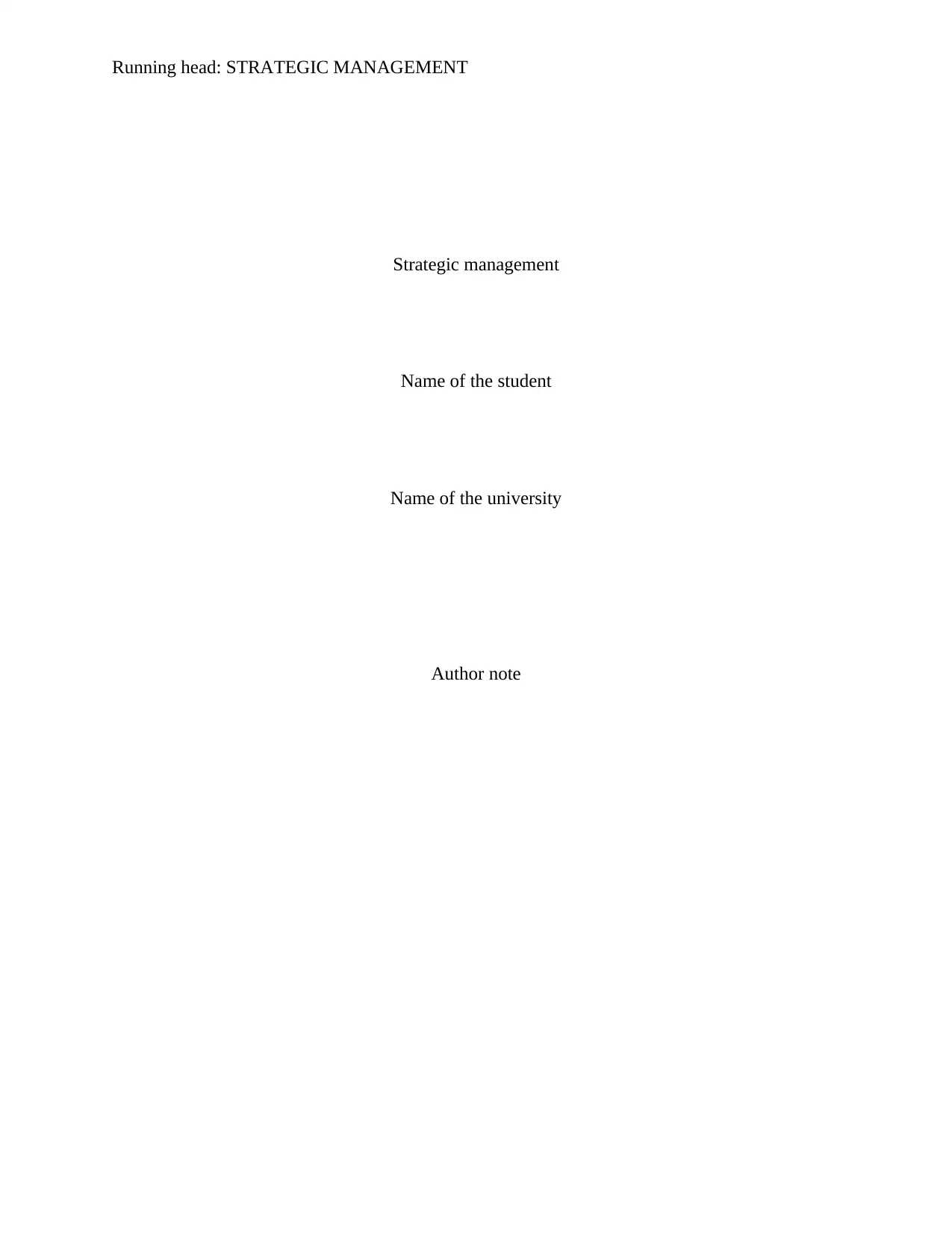
Running head: STRATEGIC MANAGEMENT
Strategic management
Name of the student
Name of the university
Author note
Strategic management
Name of the student
Name of the university
Author note
Paraphrase This Document
Need a fresh take? Get an instant paraphrase of this document with our AI Paraphraser
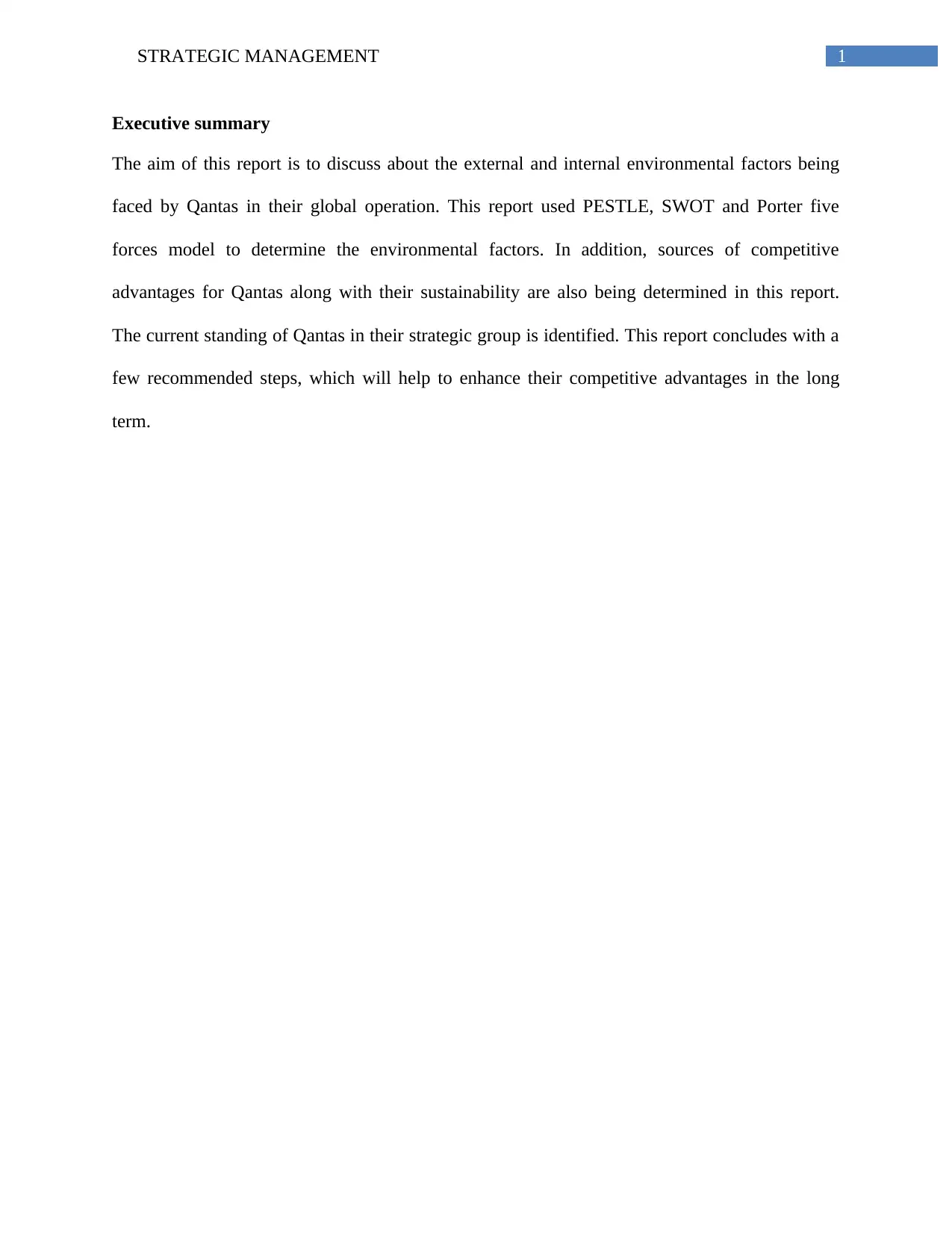
1STRATEGIC MANAGEMENT
Executive summary
The aim of this report is to discuss about the external and internal environmental factors being
faced by Qantas in their global operation. This report used PESTLE, SWOT and Porter five
forces model to determine the environmental factors. In addition, sources of competitive
advantages for Qantas along with their sustainability are also being determined in this report.
The current standing of Qantas in their strategic group is identified. This report concludes with a
few recommended steps, which will help to enhance their competitive advantages in the long
term.
Executive summary
The aim of this report is to discuss about the external and internal environmental factors being
faced by Qantas in their global operation. This report used PESTLE, SWOT and Porter five
forces model to determine the environmental factors. In addition, sources of competitive
advantages for Qantas along with their sustainability are also being determined in this report.
The current standing of Qantas in their strategic group is identified. This report concludes with a
few recommended steps, which will help to enhance their competitive advantages in the long
term.
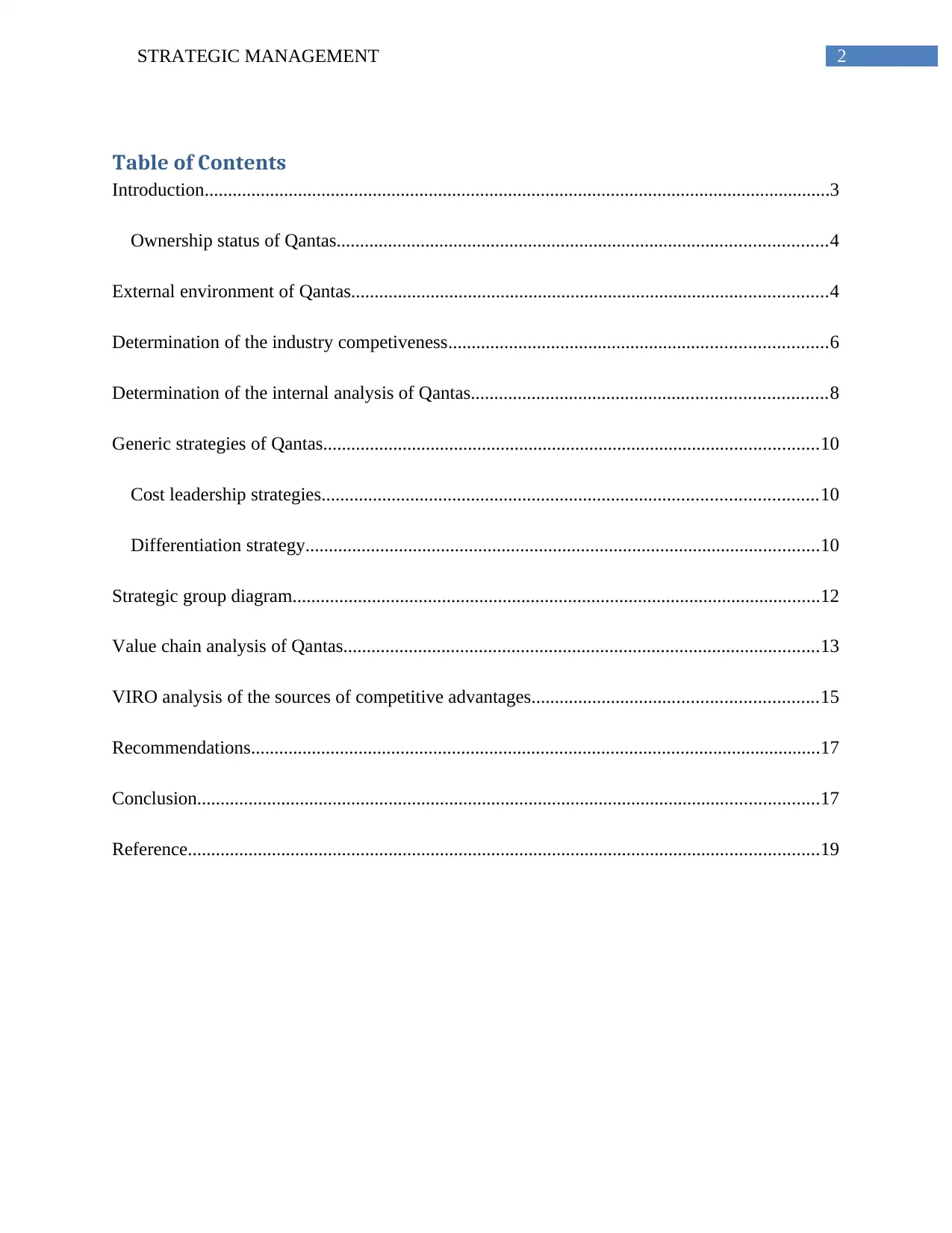
2STRATEGIC MANAGEMENT
Table of Contents
Introduction......................................................................................................................................3
Ownership status of Qantas.........................................................................................................4
External environment of Qantas......................................................................................................4
Determination of the industry competiveness.................................................................................6
Determination of the internal analysis of Qantas............................................................................8
Generic strategies of Qantas..........................................................................................................10
Cost leadership strategies..........................................................................................................10
Differentiation strategy..............................................................................................................10
Strategic group diagram.................................................................................................................12
Value chain analysis of Qantas......................................................................................................13
VIRO analysis of the sources of competitive advantages.............................................................15
Recommendations..........................................................................................................................17
Conclusion.....................................................................................................................................17
Reference.......................................................................................................................................19
Table of Contents
Introduction......................................................................................................................................3
Ownership status of Qantas.........................................................................................................4
External environment of Qantas......................................................................................................4
Determination of the industry competiveness.................................................................................6
Determination of the internal analysis of Qantas............................................................................8
Generic strategies of Qantas..........................................................................................................10
Cost leadership strategies..........................................................................................................10
Differentiation strategy..............................................................................................................10
Strategic group diagram.................................................................................................................12
Value chain analysis of Qantas......................................................................................................13
VIRO analysis of the sources of competitive advantages.............................................................15
Recommendations..........................................................................................................................17
Conclusion.....................................................................................................................................17
Reference.......................................................................................................................................19
⊘ This is a preview!⊘
Do you want full access?
Subscribe today to unlock all pages.

Trusted by 1+ million students worldwide
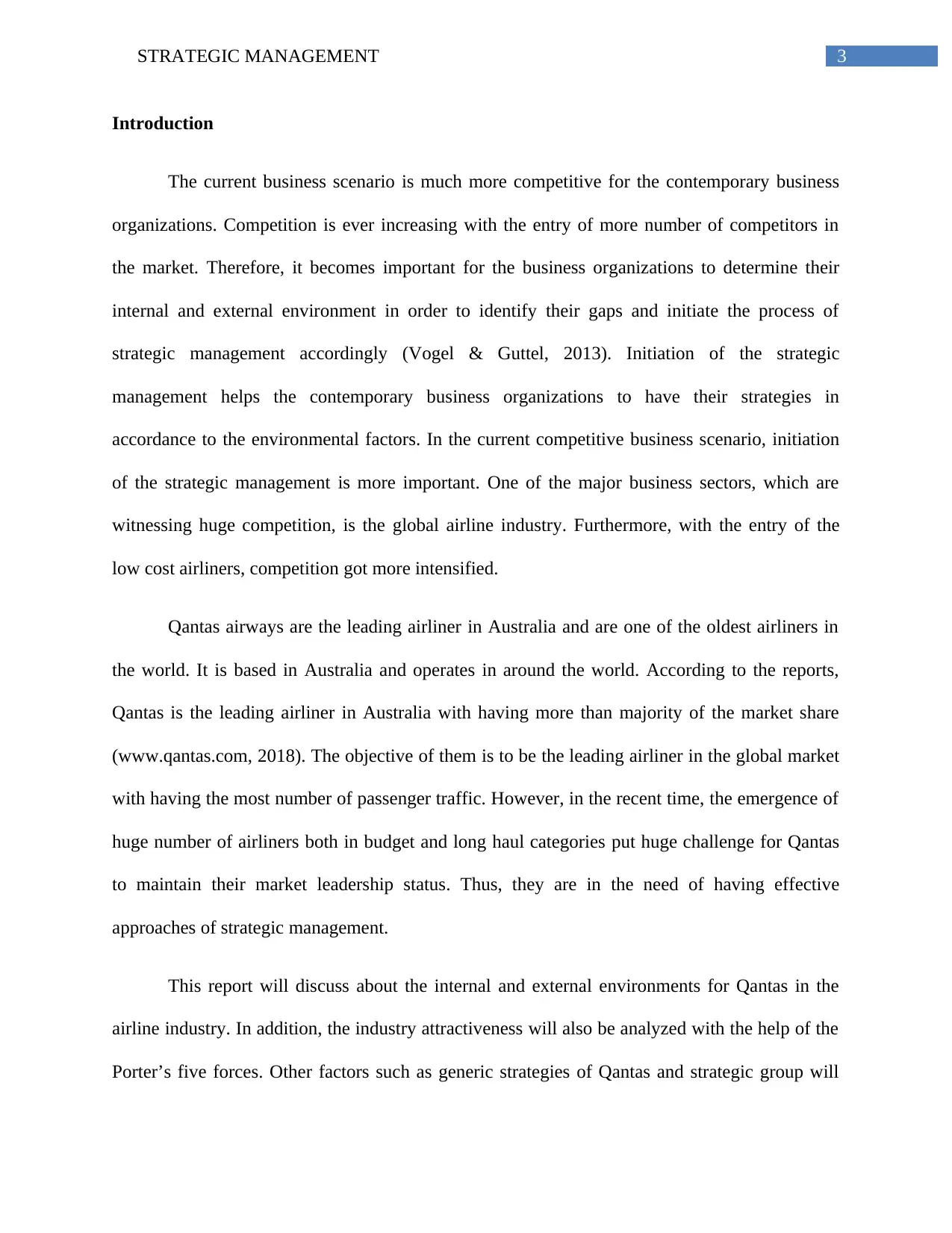
3STRATEGIC MANAGEMENT
Introduction
The current business scenario is much more competitive for the contemporary business
organizations. Competition is ever increasing with the entry of more number of competitors in
the market. Therefore, it becomes important for the business organizations to determine their
internal and external environment in order to identify their gaps and initiate the process of
strategic management accordingly (Vogel & Guttel, 2013). Initiation of the strategic
management helps the contemporary business organizations to have their strategies in
accordance to the environmental factors. In the current competitive business scenario, initiation
of the strategic management is more important. One of the major business sectors, which are
witnessing huge competition, is the global airline industry. Furthermore, with the entry of the
low cost airliners, competition got more intensified.
Qantas airways are the leading airliner in Australia and are one of the oldest airliners in
the world. It is based in Australia and operates in around the world. According to the reports,
Qantas is the leading airliner in Australia with having more than majority of the market share
(www.qantas.com, 2018). The objective of them is to be the leading airliner in the global market
with having the most number of passenger traffic. However, in the recent time, the emergence of
huge number of airliners both in budget and long haul categories put huge challenge for Qantas
to maintain their market leadership status. Thus, they are in the need of having effective
approaches of strategic management.
This report will discuss about the internal and external environments for Qantas in the
airline industry. In addition, the industry attractiveness will also be analyzed with the help of the
Porter’s five forces. Other factors such as generic strategies of Qantas and strategic group will
Introduction
The current business scenario is much more competitive for the contemporary business
organizations. Competition is ever increasing with the entry of more number of competitors in
the market. Therefore, it becomes important for the business organizations to determine their
internal and external environment in order to identify their gaps and initiate the process of
strategic management accordingly (Vogel & Guttel, 2013). Initiation of the strategic
management helps the contemporary business organizations to have their strategies in
accordance to the environmental factors. In the current competitive business scenario, initiation
of the strategic management is more important. One of the major business sectors, which are
witnessing huge competition, is the global airline industry. Furthermore, with the entry of the
low cost airliners, competition got more intensified.
Qantas airways are the leading airliner in Australia and are one of the oldest airliners in
the world. It is based in Australia and operates in around the world. According to the reports,
Qantas is the leading airliner in Australia with having more than majority of the market share
(www.qantas.com, 2018). The objective of them is to be the leading airliner in the global market
with having the most number of passenger traffic. However, in the recent time, the emergence of
huge number of airliners both in budget and long haul categories put huge challenge for Qantas
to maintain their market leadership status. Thus, they are in the need of having effective
approaches of strategic management.
This report will discuss about the internal and external environments for Qantas in the
airline industry. In addition, the industry attractiveness will also be analyzed with the help of the
Porter’s five forces. Other factors such as generic strategies of Qantas and strategic group will
Paraphrase This Document
Need a fresh take? Get an instant paraphrase of this document with our AI Paraphraser
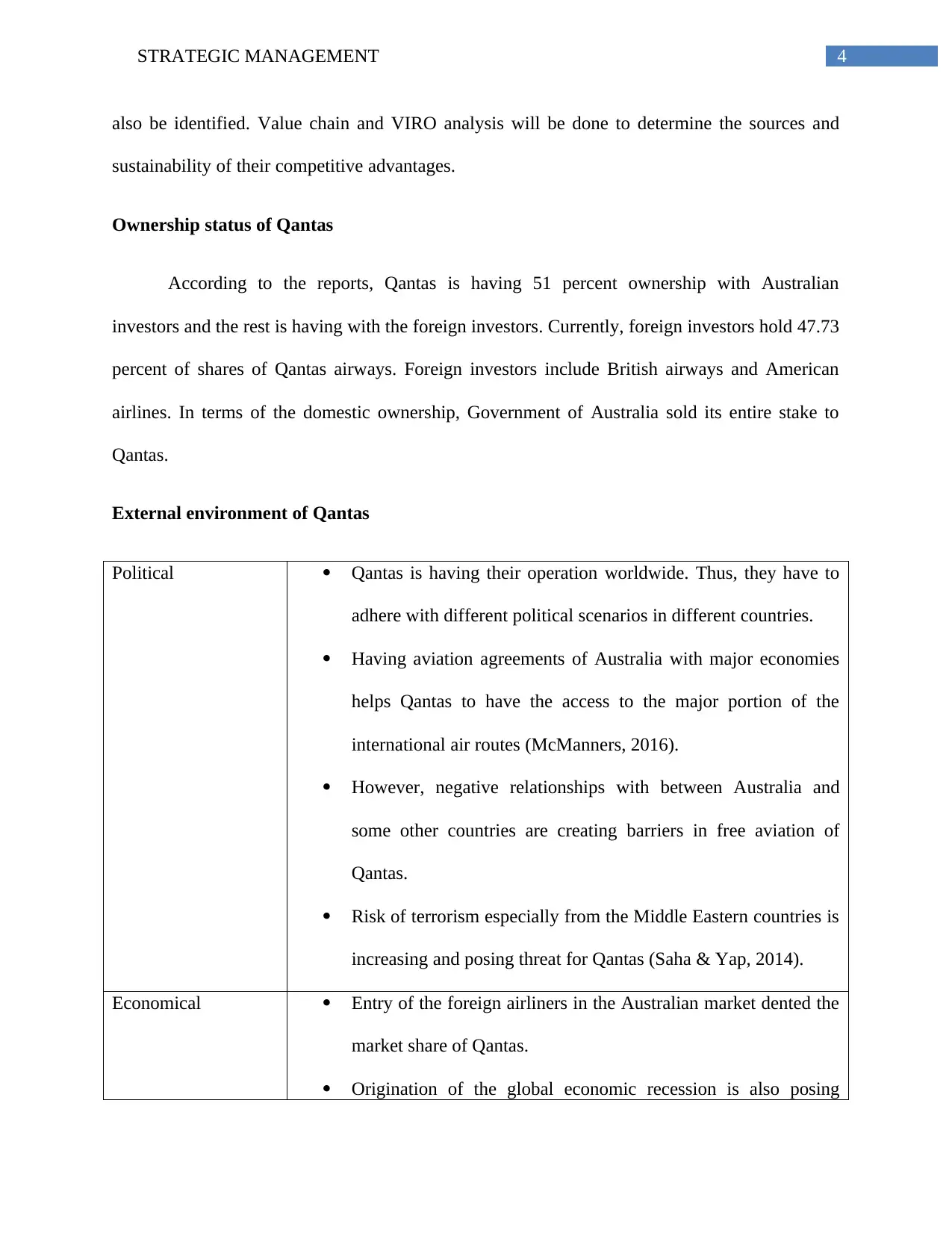
4STRATEGIC MANAGEMENT
also be identified. Value chain and VIRO analysis will be done to determine the sources and
sustainability of their competitive advantages.
Ownership status of Qantas
According to the reports, Qantas is having 51 percent ownership with Australian
investors and the rest is having with the foreign investors. Currently, foreign investors hold 47.73
percent of shares of Qantas airways. Foreign investors include British airways and American
airlines. In terms of the domestic ownership, Government of Australia sold its entire stake to
Qantas.
External environment of Qantas
Political Qantas is having their operation worldwide. Thus, they have to
adhere with different political scenarios in different countries.
Having aviation agreements of Australia with major economies
helps Qantas to have the access to the major portion of the
international air routes (McManners, 2016).
However, negative relationships with between Australia and
some other countries are creating barriers in free aviation of
Qantas.
Risk of terrorism especially from the Middle Eastern countries is
increasing and posing threat for Qantas (Saha & Yap, 2014).
Economical Entry of the foreign airliners in the Australian market dented the
market share of Qantas.
Origination of the global economic recession is also posing
also be identified. Value chain and VIRO analysis will be done to determine the sources and
sustainability of their competitive advantages.
Ownership status of Qantas
According to the reports, Qantas is having 51 percent ownership with Australian
investors and the rest is having with the foreign investors. Currently, foreign investors hold 47.73
percent of shares of Qantas airways. Foreign investors include British airways and American
airlines. In terms of the domestic ownership, Government of Australia sold its entire stake to
Qantas.
External environment of Qantas
Political Qantas is having their operation worldwide. Thus, they have to
adhere with different political scenarios in different countries.
Having aviation agreements of Australia with major economies
helps Qantas to have the access to the major portion of the
international air routes (McManners, 2016).
However, negative relationships with between Australia and
some other countries are creating barriers in free aviation of
Qantas.
Risk of terrorism especially from the Middle Eastern countries is
increasing and posing threat for Qantas (Saha & Yap, 2014).
Economical Entry of the foreign airliners in the Australian market dented the
market share of Qantas.
Origination of the global economic recession is also posing
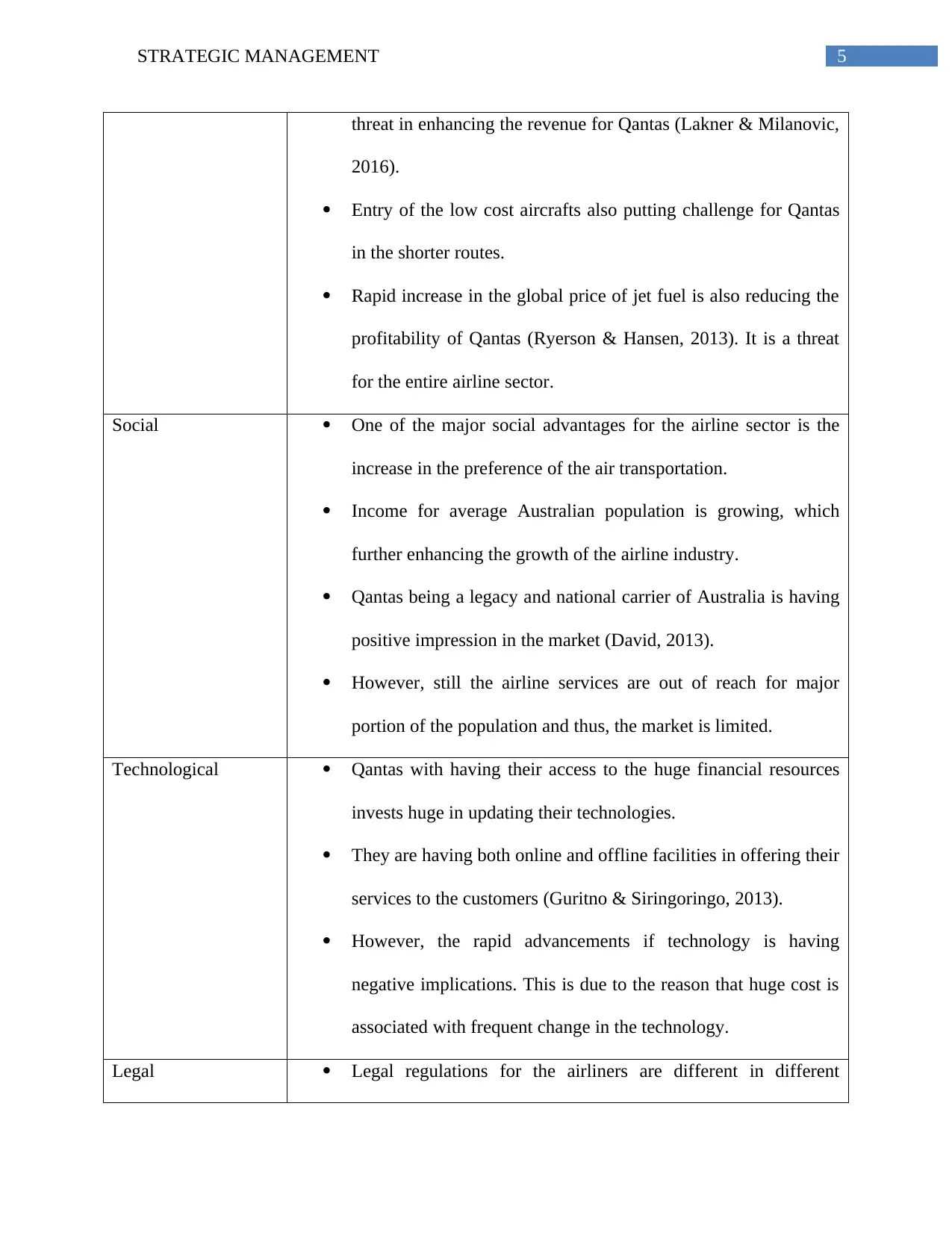
5STRATEGIC MANAGEMENT
threat in enhancing the revenue for Qantas (Lakner & Milanovic,
2016).
Entry of the low cost aircrafts also putting challenge for Qantas
in the shorter routes.
Rapid increase in the global price of jet fuel is also reducing the
profitability of Qantas (Ryerson & Hansen, 2013). It is a threat
for the entire airline sector.
Social One of the major social advantages for the airline sector is the
increase in the preference of the air transportation.
Income for average Australian population is growing, which
further enhancing the growth of the airline industry.
Qantas being a legacy and national carrier of Australia is having
positive impression in the market (David, 2013).
However, still the airline services are out of reach for major
portion of the population and thus, the market is limited.
Technological Qantas with having their access to the huge financial resources
invests huge in updating their technologies.
They are having both online and offline facilities in offering their
services to the customers (Guritno & Siringoringo, 2013).
However, the rapid advancements if technology is having
negative implications. This is due to the reason that huge cost is
associated with frequent change in the technology.
Legal Legal regulations for the airliners are different in different
threat in enhancing the revenue for Qantas (Lakner & Milanovic,
2016).
Entry of the low cost aircrafts also putting challenge for Qantas
in the shorter routes.
Rapid increase in the global price of jet fuel is also reducing the
profitability of Qantas (Ryerson & Hansen, 2013). It is a threat
for the entire airline sector.
Social One of the major social advantages for the airline sector is the
increase in the preference of the air transportation.
Income for average Australian population is growing, which
further enhancing the growth of the airline industry.
Qantas being a legacy and national carrier of Australia is having
positive impression in the market (David, 2013).
However, still the airline services are out of reach for major
portion of the population and thus, the market is limited.
Technological Qantas with having their access to the huge financial resources
invests huge in updating their technologies.
They are having both online and offline facilities in offering their
services to the customers (Guritno & Siringoringo, 2013).
However, the rapid advancements if technology is having
negative implications. This is due to the reason that huge cost is
associated with frequent change in the technology.
Legal Legal regulations for the airliners are different in different
⊘ This is a preview!⊘
Do you want full access?
Subscribe today to unlock all pages.

Trusted by 1+ million students worldwide
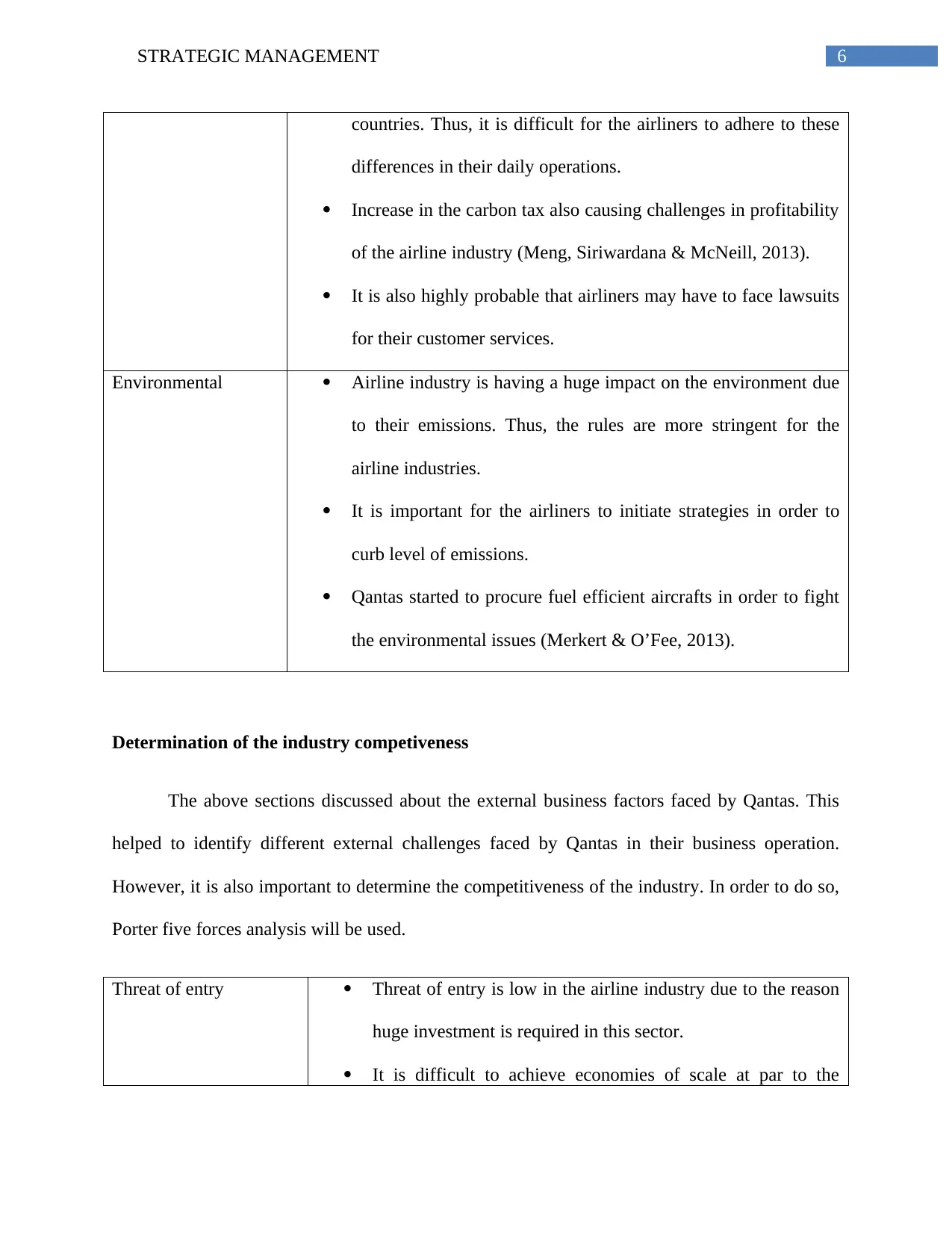
6STRATEGIC MANAGEMENT
countries. Thus, it is difficult for the airliners to adhere to these
differences in their daily operations.
Increase in the carbon tax also causing challenges in profitability
of the airline industry (Meng, Siriwardana & McNeill, 2013).
It is also highly probable that airliners may have to face lawsuits
for their customer services.
Environmental Airline industry is having a huge impact on the environment due
to their emissions. Thus, the rules are more stringent for the
airline industries.
It is important for the airliners to initiate strategies in order to
curb level of emissions.
Qantas started to procure fuel efficient aircrafts in order to fight
the environmental issues (Merkert & O’Fee, 2013).
Determination of the industry competiveness
The above sections discussed about the external business factors faced by Qantas. This
helped to identify different external challenges faced by Qantas in their business operation.
However, it is also important to determine the competitiveness of the industry. In order to do so,
Porter five forces analysis will be used.
Threat of entry Threat of entry is low in the airline industry due to the reason
huge investment is required in this sector.
It is difficult to achieve economies of scale at par to the
countries. Thus, it is difficult for the airliners to adhere to these
differences in their daily operations.
Increase in the carbon tax also causing challenges in profitability
of the airline industry (Meng, Siriwardana & McNeill, 2013).
It is also highly probable that airliners may have to face lawsuits
for their customer services.
Environmental Airline industry is having a huge impact on the environment due
to their emissions. Thus, the rules are more stringent for the
airline industries.
It is important for the airliners to initiate strategies in order to
curb level of emissions.
Qantas started to procure fuel efficient aircrafts in order to fight
the environmental issues (Merkert & O’Fee, 2013).
Determination of the industry competiveness
The above sections discussed about the external business factors faced by Qantas. This
helped to identify different external challenges faced by Qantas in their business operation.
However, it is also important to determine the competitiveness of the industry. In order to do so,
Porter five forces analysis will be used.
Threat of entry Threat of entry is low in the airline industry due to the reason
huge investment is required in this sector.
It is difficult to achieve economies of scale at par to the
Paraphrase This Document
Need a fresh take? Get an instant paraphrase of this document with our AI Paraphraser
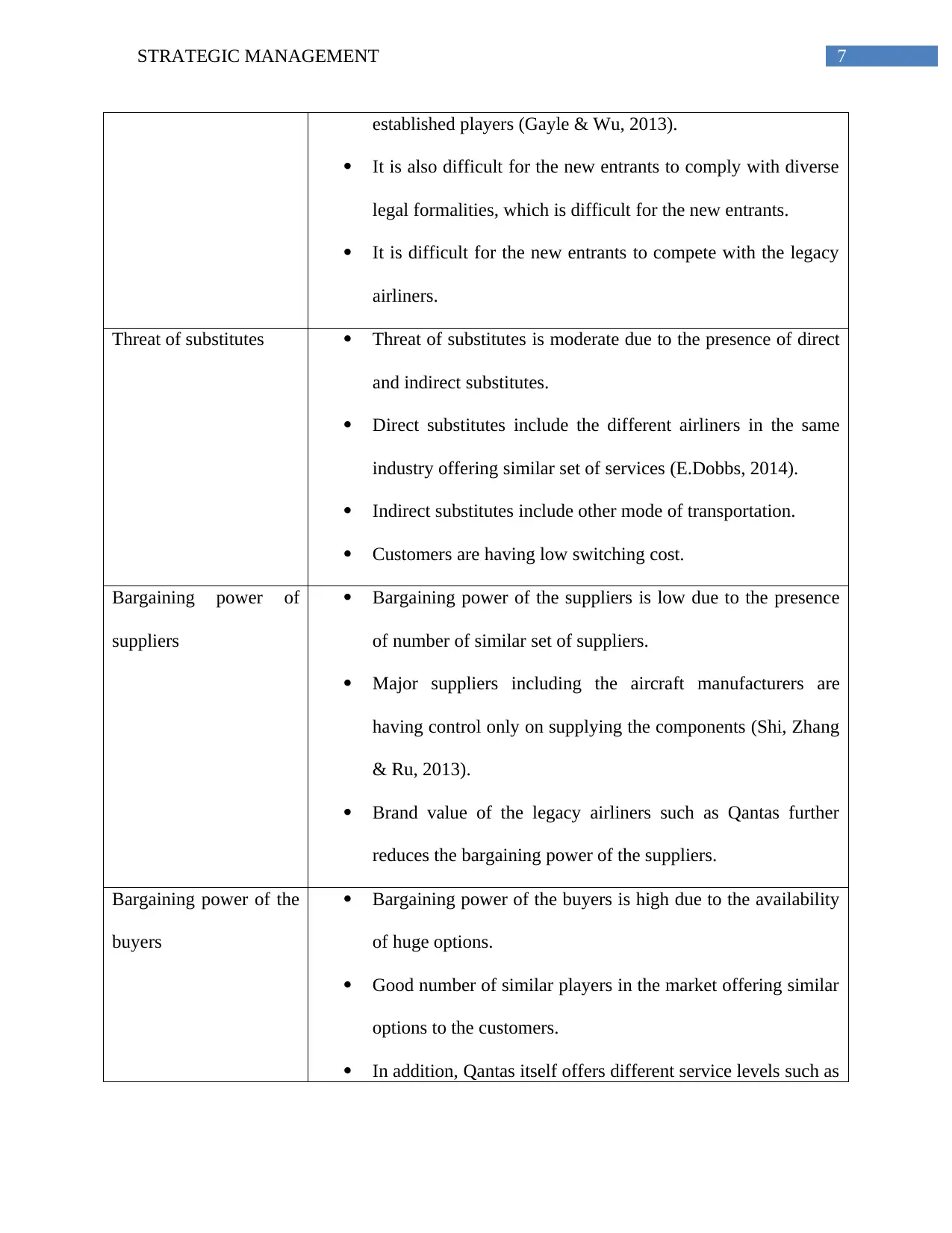
7STRATEGIC MANAGEMENT
established players (Gayle & Wu, 2013).
It is also difficult for the new entrants to comply with diverse
legal formalities, which is difficult for the new entrants.
It is difficult for the new entrants to compete with the legacy
airliners.
Threat of substitutes Threat of substitutes is moderate due to the presence of direct
and indirect substitutes.
Direct substitutes include the different airliners in the same
industry offering similar set of services (E.Dobbs, 2014).
Indirect substitutes include other mode of transportation.
Customers are having low switching cost.
Bargaining power of
suppliers
Bargaining power of the suppliers is low due to the presence
of number of similar set of suppliers.
Major suppliers including the aircraft manufacturers are
having control only on supplying the components (Shi, Zhang
& Ru, 2013).
Brand value of the legacy airliners such as Qantas further
reduces the bargaining power of the suppliers.
Bargaining power of the
buyers
Bargaining power of the buyers is high due to the availability
of huge options.
Good number of similar players in the market offering similar
options to the customers.
In addition, Qantas itself offers different service levels such as
established players (Gayle & Wu, 2013).
It is also difficult for the new entrants to comply with diverse
legal formalities, which is difficult for the new entrants.
It is difficult for the new entrants to compete with the legacy
airliners.
Threat of substitutes Threat of substitutes is moderate due to the presence of direct
and indirect substitutes.
Direct substitutes include the different airliners in the same
industry offering similar set of services (E.Dobbs, 2014).
Indirect substitutes include other mode of transportation.
Customers are having low switching cost.
Bargaining power of
suppliers
Bargaining power of the suppliers is low due to the presence
of number of similar set of suppliers.
Major suppliers including the aircraft manufacturers are
having control only on supplying the components (Shi, Zhang
& Ru, 2013).
Brand value of the legacy airliners such as Qantas further
reduces the bargaining power of the suppliers.
Bargaining power of the
buyers
Bargaining power of the buyers is high due to the availability
of huge options.
Good number of similar players in the market offering similar
options to the customers.
In addition, Qantas itself offers different service levels such as
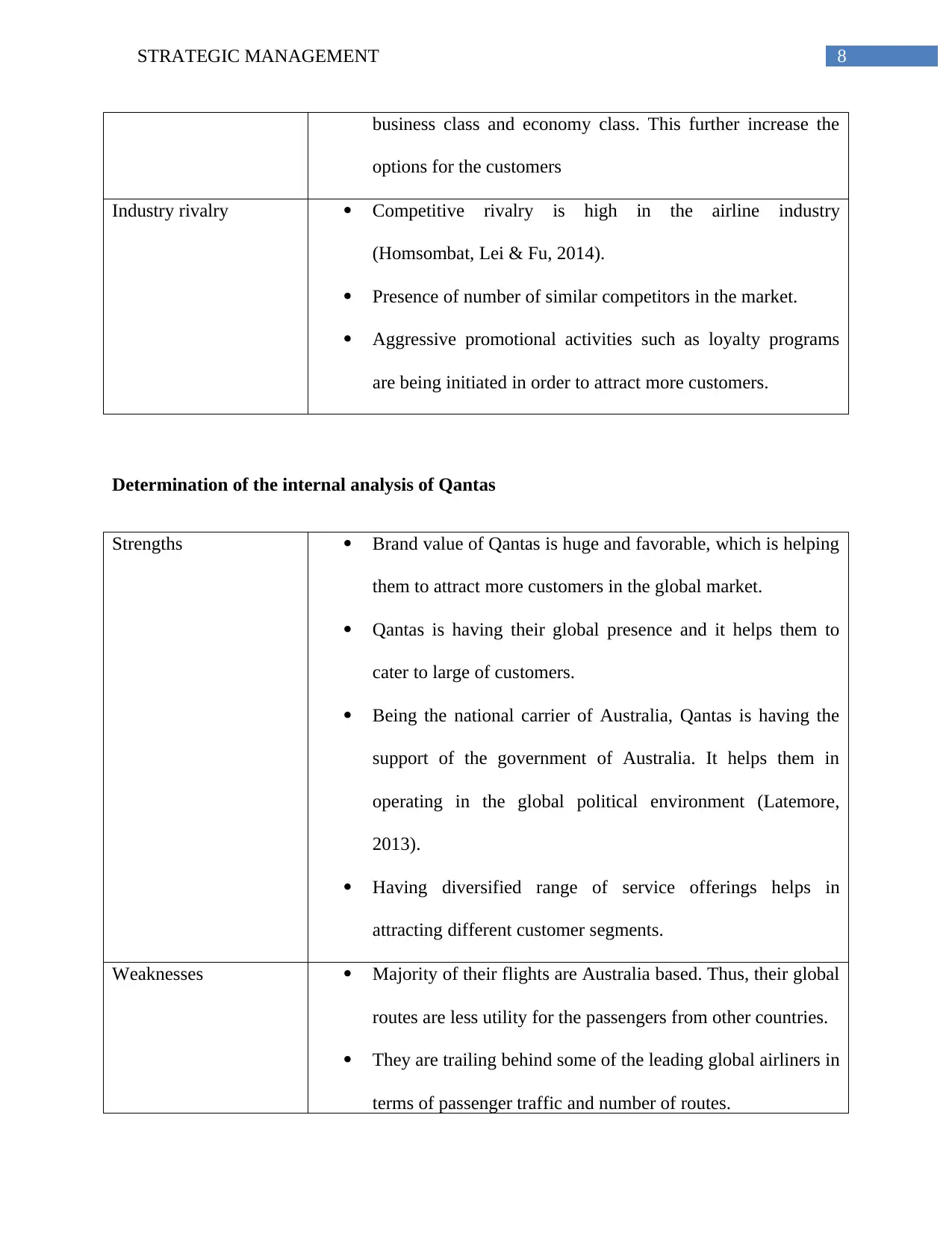
8STRATEGIC MANAGEMENT
business class and economy class. This further increase the
options for the customers
Industry rivalry Competitive rivalry is high in the airline industry
(Homsombat, Lei & Fu, 2014).
Presence of number of similar competitors in the market.
Aggressive promotional activities such as loyalty programs
are being initiated in order to attract more customers.
Determination of the internal analysis of Qantas
Strengths Brand value of Qantas is huge and favorable, which is helping
them to attract more customers in the global market.
Qantas is having their global presence and it helps them to
cater to large of customers.
Being the national carrier of Australia, Qantas is having the
support of the government of Australia. It helps them in
operating in the global political environment (Latemore,
2013).
Having diversified range of service offerings helps in
attracting different customer segments.
Weaknesses Majority of their flights are Australia based. Thus, their global
routes are less utility for the passengers from other countries.
They are trailing behind some of the leading global airliners in
terms of passenger traffic and number of routes.
business class and economy class. This further increase the
options for the customers
Industry rivalry Competitive rivalry is high in the airline industry
(Homsombat, Lei & Fu, 2014).
Presence of number of similar competitors in the market.
Aggressive promotional activities such as loyalty programs
are being initiated in order to attract more customers.
Determination of the internal analysis of Qantas
Strengths Brand value of Qantas is huge and favorable, which is helping
them to attract more customers in the global market.
Qantas is having their global presence and it helps them to
cater to large of customers.
Being the national carrier of Australia, Qantas is having the
support of the government of Australia. It helps them in
operating in the global political environment (Latemore,
2013).
Having diversified range of service offerings helps in
attracting different customer segments.
Weaknesses Majority of their flights are Australia based. Thus, their global
routes are less utility for the passengers from other countries.
They are trailing behind some of the leading global airliners in
terms of passenger traffic and number of routes.
⊘ This is a preview!⊘
Do you want full access?
Subscribe today to unlock all pages.

Trusted by 1+ million students worldwide
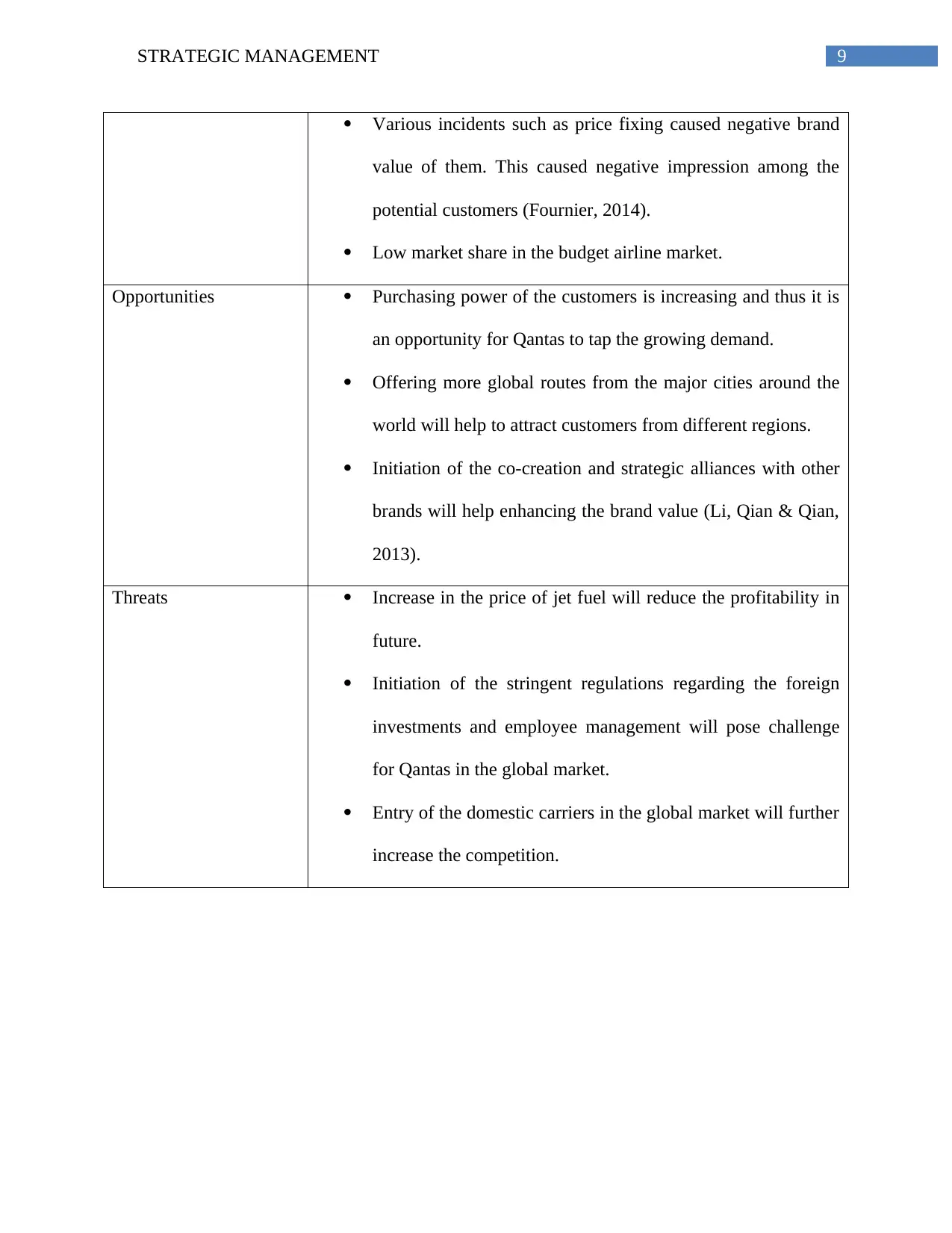
9STRATEGIC MANAGEMENT
Various incidents such as price fixing caused negative brand
value of them. This caused negative impression among the
potential customers (Fournier, 2014).
Low market share in the budget airline market.
Opportunities Purchasing power of the customers is increasing and thus it is
an opportunity for Qantas to tap the growing demand.
Offering more global routes from the major cities around the
world will help to attract customers from different regions.
Initiation of the co-creation and strategic alliances with other
brands will help enhancing the brand value (Li, Qian & Qian,
2013).
Threats Increase in the price of jet fuel will reduce the profitability in
future.
Initiation of the stringent regulations regarding the foreign
investments and employee management will pose challenge
for Qantas in the global market.
Entry of the domestic carriers in the global market will further
increase the competition.
Various incidents such as price fixing caused negative brand
value of them. This caused negative impression among the
potential customers (Fournier, 2014).
Low market share in the budget airline market.
Opportunities Purchasing power of the customers is increasing and thus it is
an opportunity for Qantas to tap the growing demand.
Offering more global routes from the major cities around the
world will help to attract customers from different regions.
Initiation of the co-creation and strategic alliances with other
brands will help enhancing the brand value (Li, Qian & Qian,
2013).
Threats Increase in the price of jet fuel will reduce the profitability in
future.
Initiation of the stringent regulations regarding the foreign
investments and employee management will pose challenge
for Qantas in the global market.
Entry of the domestic carriers in the global market will further
increase the competition.
Paraphrase This Document
Need a fresh take? Get an instant paraphrase of this document with our AI Paraphraser
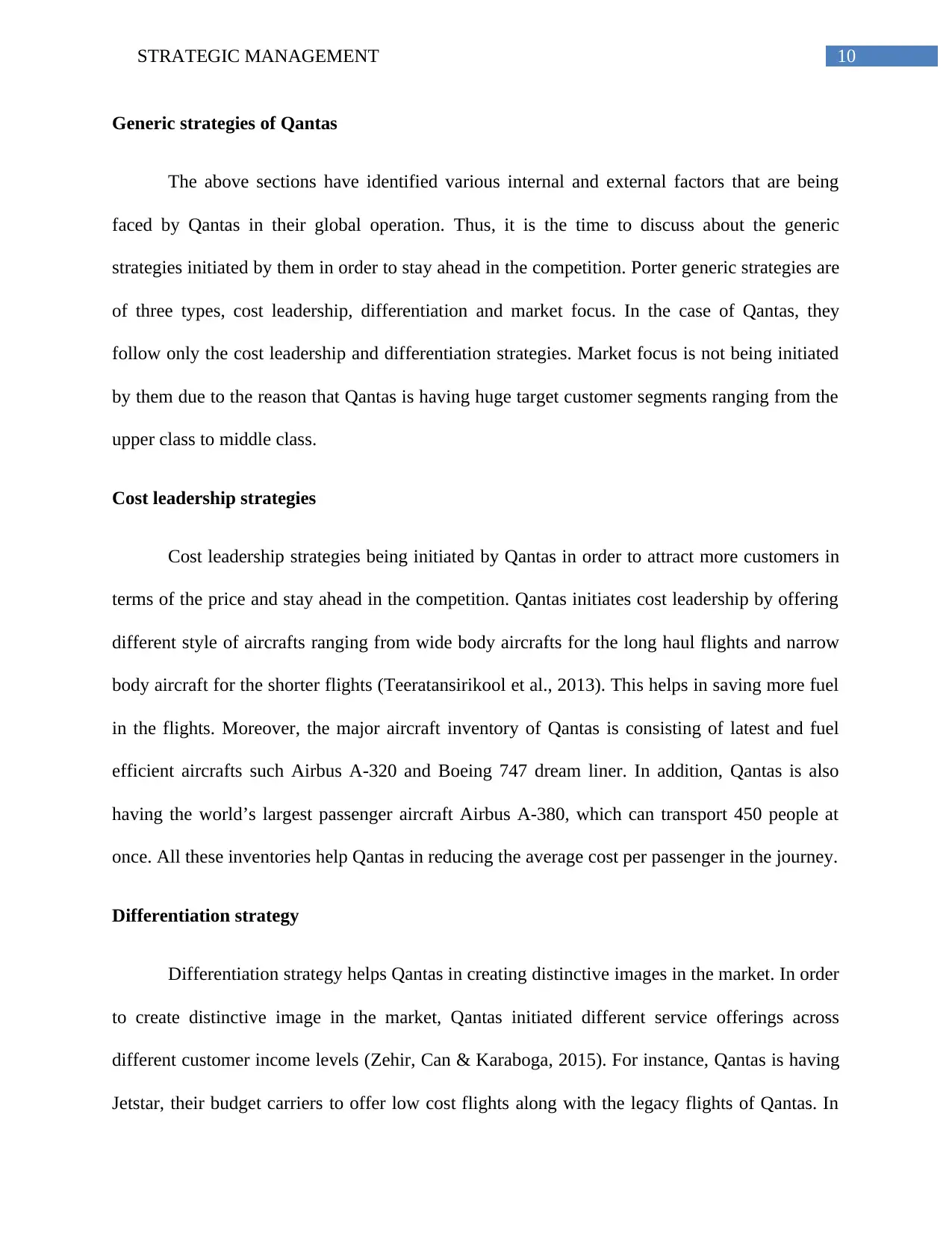
10STRATEGIC MANAGEMENT
Generic strategies of Qantas
The above sections have identified various internal and external factors that are being
faced by Qantas in their global operation. Thus, it is the time to discuss about the generic
strategies initiated by them in order to stay ahead in the competition. Porter generic strategies are
of three types, cost leadership, differentiation and market focus. In the case of Qantas, they
follow only the cost leadership and differentiation strategies. Market focus is not being initiated
by them due to the reason that Qantas is having huge target customer segments ranging from the
upper class to middle class.
Cost leadership strategies
Cost leadership strategies being initiated by Qantas in order to attract more customers in
terms of the price and stay ahead in the competition. Qantas initiates cost leadership by offering
different style of aircrafts ranging from wide body aircrafts for the long haul flights and narrow
body aircraft for the shorter flights (Teeratansirikool et al., 2013). This helps in saving more fuel
in the flights. Moreover, the major aircraft inventory of Qantas is consisting of latest and fuel
efficient aircrafts such Airbus A-320 and Boeing 747 dream liner. In addition, Qantas is also
having the world’s largest passenger aircraft Airbus A-380, which can transport 450 people at
once. All these inventories help Qantas in reducing the average cost per passenger in the journey.
Differentiation strategy
Differentiation strategy helps Qantas in creating distinctive images in the market. In order
to create distinctive image in the market, Qantas initiated different service offerings across
different customer income levels (Zehir, Can & Karaboga, 2015). For instance, Qantas is having
Jetstar, their budget carriers to offer low cost flights along with the legacy flights of Qantas. In
Generic strategies of Qantas
The above sections have identified various internal and external factors that are being
faced by Qantas in their global operation. Thus, it is the time to discuss about the generic
strategies initiated by them in order to stay ahead in the competition. Porter generic strategies are
of three types, cost leadership, differentiation and market focus. In the case of Qantas, they
follow only the cost leadership and differentiation strategies. Market focus is not being initiated
by them due to the reason that Qantas is having huge target customer segments ranging from the
upper class to middle class.
Cost leadership strategies
Cost leadership strategies being initiated by Qantas in order to attract more customers in
terms of the price and stay ahead in the competition. Qantas initiates cost leadership by offering
different style of aircrafts ranging from wide body aircrafts for the long haul flights and narrow
body aircraft for the shorter flights (Teeratansirikool et al., 2013). This helps in saving more fuel
in the flights. Moreover, the major aircraft inventory of Qantas is consisting of latest and fuel
efficient aircrafts such Airbus A-320 and Boeing 747 dream liner. In addition, Qantas is also
having the world’s largest passenger aircraft Airbus A-380, which can transport 450 people at
once. All these inventories help Qantas in reducing the average cost per passenger in the journey.
Differentiation strategy
Differentiation strategy helps Qantas in creating distinctive images in the market. In order
to create distinctive image in the market, Qantas initiated different service offerings across
different customer income levels (Zehir, Can & Karaboga, 2015). For instance, Qantas is having
Jetstar, their budget carriers to offer low cost flights along with the legacy flights of Qantas. In
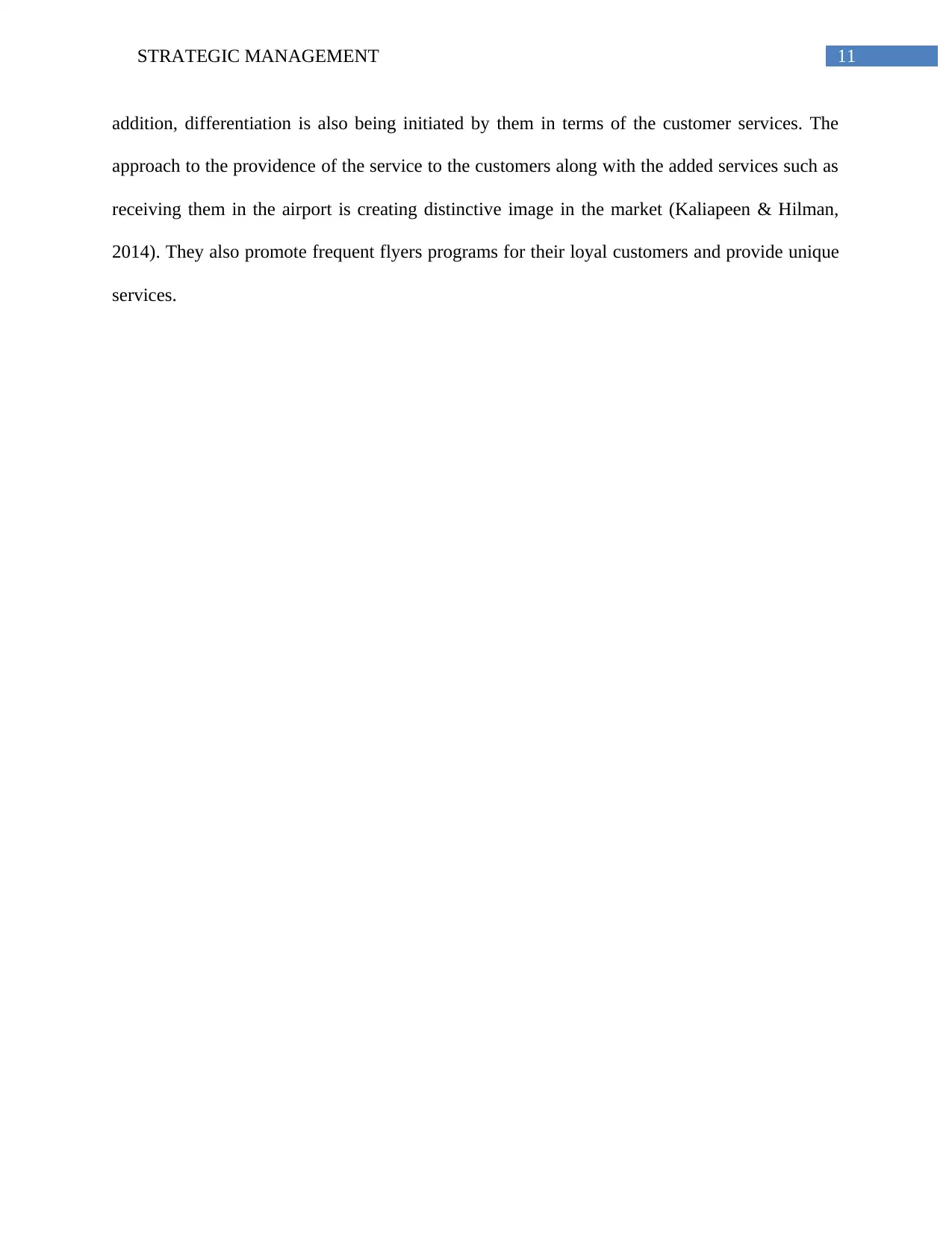
11STRATEGIC MANAGEMENT
addition, differentiation is also being initiated by them in terms of the customer services. The
approach to the providence of the service to the customers along with the added services such as
receiving them in the airport is creating distinctive image in the market (Kaliapeen & Hilman,
2014). They also promote frequent flyers programs for their loyal customers and provide unique
services.
addition, differentiation is also being initiated by them in terms of the customer services. The
approach to the providence of the service to the customers along with the added services such as
receiving them in the airport is creating distinctive image in the market (Kaliapeen & Hilman,
2014). They also promote frequent flyers programs for their loyal customers and provide unique
services.
⊘ This is a preview!⊘
Do you want full access?
Subscribe today to unlock all pages.

Trusted by 1+ million students worldwide
1 out of 18
Related Documents
Your All-in-One AI-Powered Toolkit for Academic Success.
+13062052269
info@desklib.com
Available 24*7 on WhatsApp / Email
![[object Object]](/_next/static/media/star-bottom.7253800d.svg)
Unlock your academic potential
Copyright © 2020–2025 A2Z Services. All Rights Reserved. Developed and managed by ZUCOL.




